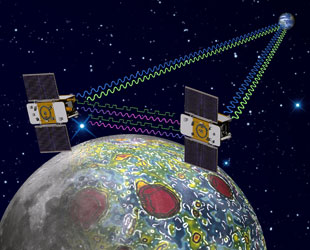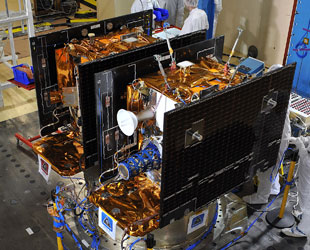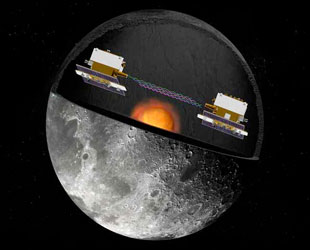January 17, 2012 — NASA's twin, gravity-mapping moon probes received new names Tuesday (Jan. 17), reflecting their mission to study the changing pull of Earth's natural satellite.
Now to be called "Ebb" and "Flow," the tandem Gravity Recovery And Interior Laboratory, or GRAIL, spacecraft arrived in lunar orbit on New Year's Eve and New Year's Day referred to simply "A" and "B". Their new names were offered by fourth grade students in Bozeman, Mont., who were chosen as the winners of NASA's naming contest.
"The 28 students of Ms. Nina DiMauro's class at Emily Dickinson Elementary School have really hit the nail on the head," said Maria Zuber, who as principal investigator leads the GRAIL probes' mission from the Massachusetts Institute of Technology. "We were really impressed that the students drew their inspiration by researching GRAIL and its goal of measuring gravity."
"Ebb and Flow truly capture the spirit and excitement of our mission," Zuber said.

NASA's Ebb and Flow tandem spacecraft will use radio waves to measure their distance apart as they orbit the moon. (NASA) |
The terms ebb and flow generally refer to the movement of water, especially in relation to Earth's natural tides that are influenced by the pull of the moon. The two words also describe the relative motion of the GRAIL probes, which will vary in distance with the moon's gravitational pull.
"While we feel the ebb and flow of our tides, our twins will undergo nearly the same motion as they study our lunar neighbor," said Jim Green, who leads NASA's planetary science division in Washington, DC.
First prize
According to NASA, about 900 classrooms with more than 11,000 students from 45 states — as well as Puerto Rico and the District of Columbia — suggested names. The contest, which was open to U.S. students in kindergarten through 12th grade, began about a month after the probes were launched last September and ran through Nov. 11.
Zuber and former astronaut Sally Ride, the first American woman in space, selected served as the contest's judges.
"With submissions from all over the United States and even some from abroad, there were a lot of great entries to look over," said Ride, who is now president and CEO of Sally Ride Science in San Diego. "This contest generated a great deal of excitement in classrooms across America, and along with it an opportunity to use that excitement to teach science."

The GRAIL probes Ebb (foreground) and Flow seen as they were being prepared for their launch to the moon. (NASA/JPL-Caltech) |
As their first prize for naming Ebb and Flow, the Dickinson students won the first pick of where to point MoonKam, a small camera on board each of the GRAIL probes.
MoonKam, or Moon Knowledge Acquired by Middle school students, is NASA's first instrument to fly on a planetary mission fully-dedicated to education and public outreach. Managed by Sally Ride Science, MoonKam will provide thousands of fifth- to eighth-grade students the chance to select areas on the lunar surface to be photographed.
Ebbing and flowing
MoonKam will start sending back images once Ebb and Flow begin science operations in March.
Since the two probes entered lunar orbit two weeks ago, flight controllers have been refining each spacecraft's orbit to reduce the time they take to circle the moon to just under two hours. At the start of the science phase in two months, Ebb and Flow will be in a near-polar, near-circular orbit with an altitude of about 34 miles (55 kilometers).
During their science mission, the washer-machine size spacecraft will transmit radio signals precisely defining the distance between them. As they fly over areas of greater and lesser gravity caused by visible features such as mountains and craters, as well as masses hidden beneath the lunar surface, the distance between Ebb and Flow will change slightly.

The data collected by the GRAIL mission will enable scientists to better understand what goes on below the lunar surface. (NASA) |
Scientists will use this data to form a high-resolution map of the moon's gravitational field, providing them a better understanding of what is going on below the lunar surface. This information will increase knowledge of how Earth and its rocky neighbors in the inner solar system developed into the diverse worlds they are today.
Student namers
The Dickinson students are now among a small group of children who have named NASA spacecraft.
NASA's previous twins, the Mars Exploration Rovers sent to the Red Planet in 2004, were also named by students taking part in an essay contest. Sofi Collis, a third-grade Russian-American student from Arizona, suggested Spirit and Opportunity.
"I used to live in an orphanage. It was dark and cold and lonely. At night, I looked up at the sparkly sky and felt better. I dreamed I could fly there. In America, I can make all my dreams come true. Thank you for the 'Spirit' and the 'Opportunity,'" Collis wrote in her winning essay.
NASA repeated the process with for follow-on Mars rover. Clara Ma, a sixth-grader from Kansas, offered the winning name, Curiosity, writing that "curiosity is the passion that drives us through our everyday lives."
The car-size Curiosity was launched in November and is now on its way to Mars. It is scheduled to land on Aug. 6.
NASA's first spacecraft naming contest open to students, which was announced by President George H.W. Bush in 1989, was for its fifth and final space shuttle orbiter. The space agency received 6,154 entries, representing more than 70,000 students.
Shuttle Endeavour, which was retired in June after its 25th spaceflight, was named by elementary and middle school students in Georgia and Mississippi.
